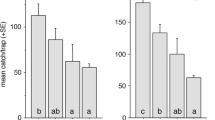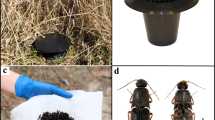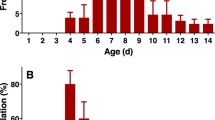Abstract
Laboratory and field investigations were carried out to investigate the nature and role of the male pheromone emitted by the Dynast beetle Scapanes australis and to develop a mass trapping technique against this major coconut pest in Papua New Guinea. We report the biological data obtained from natural and synthetic pheromone, previously described as an 84:12:4 (w/w) mixture of 2-butanol (1), 3-hydoxy-2-butanone (2), and 2,3-butanediol (3). EAG recordings from natural and synthetic pheromone and a pitfall olfactometer were poorly informative. In contrast, extensive field trapping trials with various synthetic pheromone mixtures and doses showed that 1 and 2 (formulated in polyethylene sachets in 90:5 v:v ratio) were necessary and sufficient for optimum long-range attraction. Beetles were captured in traps baited with racemic 1 plus 2, with or without a stereoisomer mixture of 3 (2.5- to 2500-mg/day doses). Plant pieces, either sugarcane or coconut, enhanced captures by the synthetic pheromone, which was active alone. Traps with the pheromone caught both sexes in a 3:2 female–male ratio. A pheromone-based mass trapping led to the capture of 2173 beetles in 14 traps surrounding 40 ha of a cocoa-coconut plantation. The captures followed a log-linear decrease during the 125-week trapping program. The role of the male pheromone and its potential for crop protection are discussed.
Similar content being viewed by others
REFERENCES
Beaudoin-Ollivier, L., Morin, J.-P., Prior, R. N. B., Kakul, T., Ollivier, J., Rochat, D., and Mariau, D. 1999. Le complexe Scapanes-Rhynchophorus, principal problème entomologique du cocotier en Papouasie-Nouvelle-Guin´ee. Plant. Rech. Dev. 6:46–55.
Bedford, G. O. 1976. Observation on the biology and ecology of Oryctes rhinoceros and Scapanes australis: Pests of coconut palms in Melanesia. J. Entomol. Soc. 15:241–251.
Chung, G. F. 1997. The bioefficacy of the aggregation pheromone in mass trapping of rhinoceros beetles (Oryctes rhinoceros L.) in Malaysia. The Planter (Kuala Lumpur) 73:119–127.
Dechambre, R. P. 1995. Deux nouveaux Oryctini de Nouvelle Guin´ee (Coleoptera, Dynastidae). Coleoptěres 1:58–63.
Gries, G., Gries, R., Perez, A. L., Oehlschlager, A. C., Gonzalez, L. M., Pierce, H. D., Jr., Zebeyou, M., and Kouame, B. 1994. Aggregation pheromone of the African rhinoceros beetles, Oryctes monoceros (Olivier) (Coleoptera: Scarabaeidae). Z. Naturforsch. 49c:363–366.
Hallet, R. H., Perez, A. L., Gries, G., Gries, R., Pierce, H. D., Jr., Yue, J., Oehlschlager, A. C., Gonzalez, L. M., and Borden, J. H. 1995. Aggregation pheromone of the coconut rhinoceros beetles, Oryctes rhinoceros (L.) (Coleoptera: Scarabaeidae). J. Chem. Ecol. 21:1549–1570.
Hansson, B. S., Larsson, M. C., and Leal, W. S. 1999. Green leaf volatile detecting olfactory receptor neurone display very high sensitivity and specificity in a scarab beetle. Physiol. Entomol. 24:121–126.
Ho, C. T. 1996. The integrated management of Oryctes rhinoceros (L.) populations in the zero burning environment. Proceedings of the PORIM international oil palm congress, Malaysia, pp. 336–368.
Kakul, T., Laup, S., Stathers, T., Beaudoin-Ollivier, L., Morin, J.-P., and Rochat, D. 1999. Trapping and disruption of the mating activity of Scapanes australis using live male as bait in Papua New Guinea. CORD Special Ed. 15:131–149.
Leal, W. S. 1998. Chemical ecology of phytophagous Scarab beetles. Annu. Rev. Entomol. 43:39–61.
Leal, W. S. and Mochizuki, F. 1993. Sex pheromone reception in the scarab beetle Anomala cuprea. Enantiomeric discrimination by sensilla placodea. Naturwissenschaften 80:278–281.
Morin, J.-P., Rochat, D., Malosse, C., Lettere, M., Desmier De Chenon, R., Wibwo, H.,and Descoins, C. 1996. Ethyl 4-methyloctanoate, major component of Oryctes rhinoceros (L.) (Coleoptera, Dynastidae) pheromone. C. R. Acad. Sci. Paris, Life Sci. 319:595–602.
Nikonov, A. A., Valiyaveetil, J. T., and Leal, W. S. 2001.Aphotoaffinity-labeled green leaf volatile compound ‘trick’ highly selective and sensitive insect olfactory receptor neurons. Chem. Senses 26:49–54.
Nordlund, D. A. and Lewis, W. J. 1976. Terminology of chemical releasing stimuli in intraspecific and interspecific interactions. J. Chem. Ecol. 2:211–220.
Oehlschlager, A. C., Prior, R. N. B., Perez, A. L., Gries, R., Gries, G., Pierce, H. D., Jr., and Laup, S. 1995. Structure, chirality, and field testing of a male-produced aggregation pheromone of asian palm weevil, Rhynchophorus bilineatus (Montr.) (Coleoptera: Curculionidae). J. Chem. Ecol. 21:1619–1629.
Prior, R., Morin, J.-P., Rochat, D., Beaudoin-Ollivier, L., Stathers, T., Kakul, K., Embupa, S., and Nanguai, R. 2000. New aspects of the biology of the Melanesian Rhinoceros Beetle Scapanes australis (Col., Dynastidae) and evidence for field attraction to males. J. Appl. Entomol. 124:41–50.
Renou, M., Tauban, D., and Morin, J.-P. 1998. Structure and function of antennal pore plate sensilla of Oryctes rhinoceros (L.) (Coleoptera: Dynastidae). Int. J. Insect Morphol. Embryol. 27:227–233.
Robinson, R. K., Batt, C. A., and Patel, P. D. (eds.). 1999. Encyclopedia of Food Microbiology, 3 vol. Academic Press, Orlando, Florida, 2880 pp.
Rochat, D., Gonzalez, V. A., Mariau, D., Villanueva, G. A., and Zagatti, P. 1991. Evidence for male-produced aggregation pheromone in American palm weevil, Rhynchophorus palmarum (L.) (Coleoptera: Curculionidae). J. Chem. Ecol. 17:1221–1230.
Rochat, D., Ramirez-Lucas, P., Malosse, C., Rosa Aldana, R., Kakul, T., and Morin, J.-P. 2000a. Role of solid-phase microextraction in identification of highly volatile pheromones of two rhinoceros beetles Scapanes australis and Strategus aloeus (Coleoptera, Scarabaeidae, Dynastinae). J. Chromatogr. A 885:433–444.
Rochat, D., Nagnan-LeMeillour, P., Esteban-Duran, J. R., Malosse, C., Perthuis, B., Morin, J.-P., and Descoins, C. 2000b. Identification of pheromone synergists in American palm weevil, Rhynchophorus palmarum, and attraction of related Dynamis borassi (Coleoptera, Curculionidae). J. Chem. Ecol. 26:155–187.
STATITCF. 1991. Statistical Software, version 5. Institut Technique des C´er´eales et des Fourrages, Paris, France.
Author information
Authors and Affiliations
Corresponding author
Rights and permissions
About this article
Cite this article
Rochat, D., Morin, JP., Kakul, T. et al. Activity of Male Pheromone of Melanesian Rhinoceros Beetle Scapanes australis. J Chem Ecol 28, 479–500 (2002). https://doi.org/10.1023/A:1014531810037
Issue Date:
DOI: https://doi.org/10.1023/A:1014531810037




